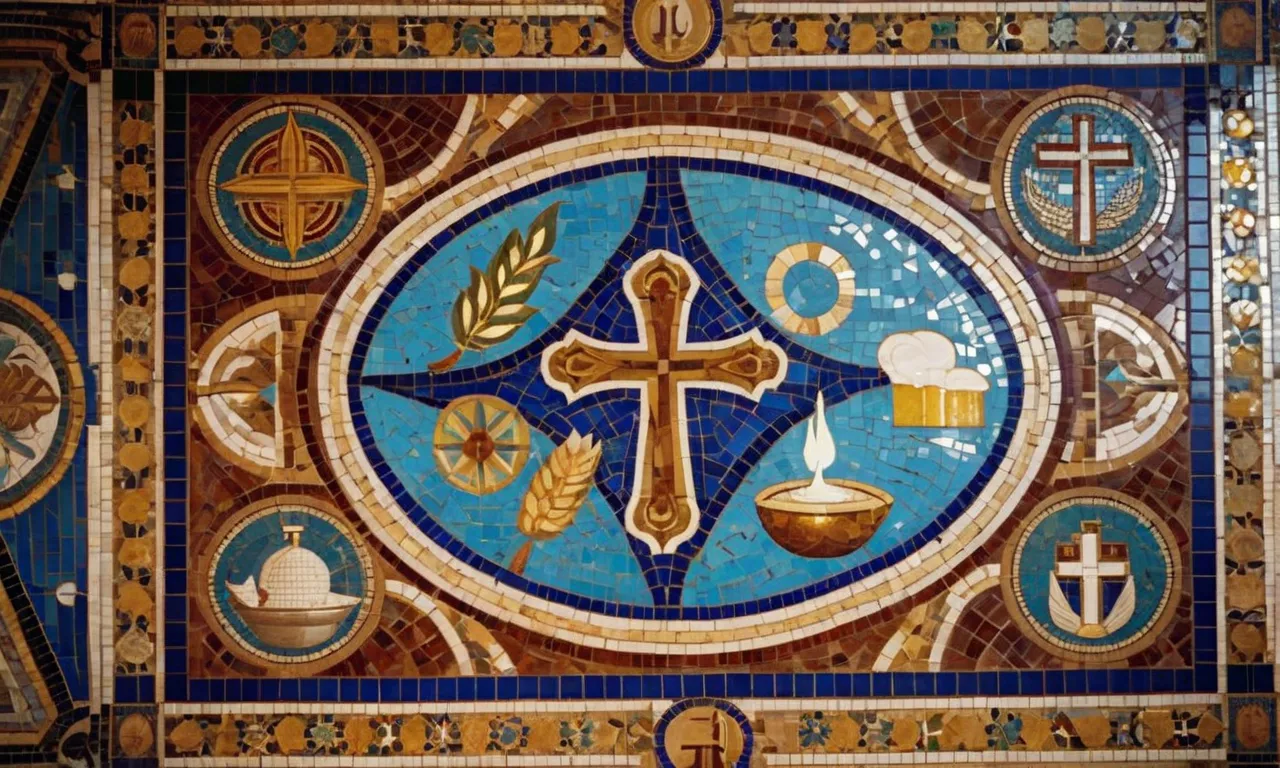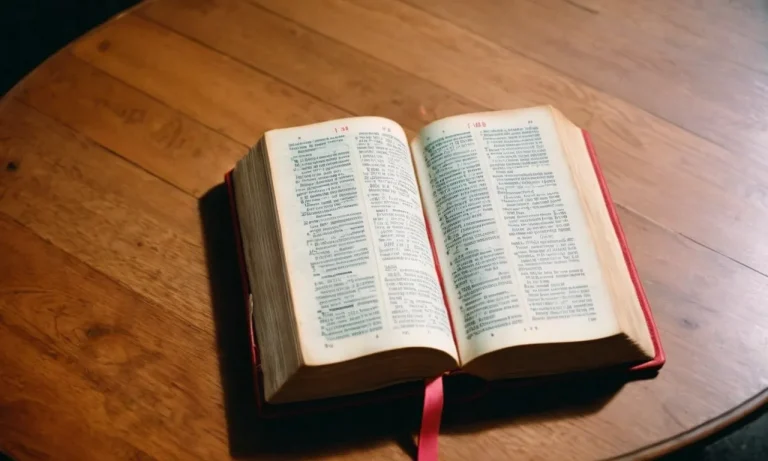7 Sacraments: Symbols And Meanings Explained
In the realm of Christianity, the sacraments hold profound significance, serving as sacred rituals that mark pivotal moments in a believer’s spiritual journey. These seven sacraments are not merely symbolic gestures but powerful channels through which divine grace is bestowed upon the faithful.
If you’re short on time, here’s a quick answer to your question: The seven sacraments of the Catholic Church are Baptism, Confirmation, Eucharist, Penance, Anointing of the Sick, Holy Orders, and Matrimony.
Each sacrament is accompanied by specific symbols and meanings that reflect its spiritual essence and purpose.
In this comprehensive article, we will delve into the rich tapestry of symbolism and meaning woven into each of the seven sacraments.
From the cleansing waters of Baptism to the sacred vows of Matrimony, we will explore the profound significance of these rituals and their impact on the lives of believers.
Baptism: The Gateway to Eternal Life
Baptism is the first of the seven sacraments in the Catholic Church, marking the beginning of a person’s spiritual journey towards eternal life.
This sacred rite holds immense significance, symbolizing the cleansing of sin and the rebirth into the Christian faith.
Through the waters of baptism, individuals are welcomed into the community of believers, embarking on a path of grace and salvation.
Water: Symbol of Purification and Rebirth
Water has long been revered as a symbol of purification and rebirth across various religions and cultures. In Christianity, the act of immersion or pouring of water over the head represents the washing away of original sin and the renewal of the soul.
The Baptismal Font: A Womb of Spiritual Renewal
The baptismal font, a basin or pool designed to hold the blessed water, serves as a symbolic womb for spiritual renewal.
Just as a child emerges from the mother’s womb into the world, the baptized individual emerges from the waters of the font, reborn into the life of Christ.
The Rite of Baptism: Welcoming the Newborn into the Faith
The rite of baptism is a beautiful and solemn ceremony that welcomes the newborn into the Christian faith. During the ritual, the candidate (or parents and godparents for infants) renounces sin and professes their belief in the Holy Trinity.
The priest or deacon then pours or immerses the candidate in the blessed waters of the baptismal font, uttering the words “I baptize you in the name of the Father, and of the Son, and of the Holy Spirit.”
This sacred moment marks the individual’s entrance into the Church and their spiritual rebirth as a child of God.
Through the waters of baptism, individuals are cleansed, reborn, and united with the universal Church, embarking on a path towards eternal life in Christ.
Confirmation: Sealing the Gift of the Holy Spirit
The Sacrament of Confirmation is a profound spiritual journey that marks a pivotal moment in a Catholic’s life.
It is a rite of passage in which the faithful are anointed with sacred chrism, receive the laying on of hands, and embrace a new identity in Christ, all while being sealed with the gift of the Holy Spirit.
The Anointing with Sacred Chrism: Empowering the Faithful
During the Confirmation ceremony, the candidate is anointed with sacred chrism, a consecrated oil made from olive oil and perfumed with balsam.
This anointing is a powerful symbol that echoes the anointing of kings, prophets, and priests in the Old Testament.
The Laying on of Hands: Invoking the Descent of the Holy Spirit
As the Bishop or priest extends his hands over the confirmandi (those being confirmed), he calls upon the Holy Spirit to bestow His sevenfold gifts: wisdom, understanding, counsel, fortitude, knowledge, piety, and fear of the Lord.
The Confirmation Name: Embracing a New Identity in Christ
In many dioceses, candidates for Confirmation are encouraged to choose a new name, often inspired by a saint or biblical figure whose life and virtues they admire.
This practice symbolizes the candidate’s desire to embrace a new identity in Christ, leaving behind their former ways and committing to living a life rooted in faith and service.
Eucharist: The Source and Summit of Christian Life
The Bread and Wine: Symbols of Christ’s Body and Blood
The Eucharist, also known as Holy Communion or the Lord’s Supper, is one of the most sacred rituals in Christianity. At its heart lies the symbolic transformation of bread and wine into the body and blood of Jesus Christ.
The Consecration: Transubstantiation and the Real Presence
In the Catholic Church, the consecration of the bread and wine is believed to involve a miraculous transformation called transubstantiation.
During the Eucharistic prayer, the priest invokes the power of the Holy Spirit, and the bread and wine are transformed into the actual body and blood of Christ, while retaining their outward appearance.
The Eucharistic Celebration: Partaking in the Paschal Mystery
The Eucharistic celebration is not merely a symbolic reenactment of the Last Supper but a profound participation in the Paschal Mystery – the passion, death, and resurrection of Jesus Christ.
By partaking in the Eucharist, Christians unite themselves with Christ’s sacrificial offering and are nourished spiritually by His body and blood.
The Eucharist is a beautiful and profound mystery that lies at the heart of Christian faith.
By partaking in this sacred ritual, believers not only commemorate Christ’s sacrifice but also experience a profound spiritual union with Him and the Church community.
The bread and wine, transformed into the body and blood of Christ, serve as powerful symbols of God’s love and redemption, nourishing the faithful and drawing them ever closer to the divine.

Penance: The Sacrament of Reconciliation
The Sacrament of Penance, also known as Reconciliation or Confession, is a profound spiritual experience that offers Catholics the opportunity to seek forgiveness for their sins and restore their relationship with God and the Church.
It is a sacrament of healing and renewal, rooted in the teachings of Jesus Christ and the tradition of the Catholic Church.
Confession: Acknowledging Sins and Seeking Forgiveness
The first step in the Sacrament of Penance is confession, where the penitent (the person seeking forgiveness) acknowledges their sins before a priest. This act of humility and honesty is a crucial step in the process of reconciliation.
Absolution: The Power to Absolve and Restore Grace
After confessing their sins, the penitent receives absolution from the priest, who, acting in the person of Christ, has the authority to absolve sins.
This absolution is a powerful moment of grace and forgiveness, where the penitent is reconciled with God and the Church.
Penance: Acts of Reparation and Spiritual Renewal
Following absolution, the priest assigns a penance, which typically involves prayers, acts of charity, or sacrifices, as a means of reparation and spiritual renewal. Penance is not a punishment but a way to make amends and grow closer to God.
The Sacrament of Penance is a beautiful and profound experience that offers Catholics the opportunity to seek forgiveness, restore their relationship with God, and embark on a journey of spiritual renewal.
Anointing of the Sick: Healing and Comfort
The Anointing of the Sick is a sacrament that brings spiritual healing and comfort to those who are suffering from illness or the frailties of old age.
It is a sacred ritual that draws upon the healing power of God’s grace, offering solace and hope to the afflicted and their loved ones.
This sacrament is deeply rooted in the teachings of the New Testament, where Jesus himself instructed his disciples to anoint the sick with oil and pray for their recovery (Mark 6:13).
The Sacred Oil: Symbol of Strength and Healing
At the heart of this sacrament lies the blessed oil, a powerful symbol of strength and healing. This consecrated oil, known as the “Oil of the Sick,” is a tangible reminder of God’s mercy and compassion.
The Laying on of Hands: Invoking Divine Mercy
In addition to the anointing with oil, the sacrament also involves the laying on of hands by the priest. This ancient gesture, practiced by Jesus himself, is a powerful invocation of the Holy Spirit and a plea for God’s mercy and healing.
As the priest lays his hands upon the sick person, he utters a prayer that calls upon the divine power to grant relief from suffering and to strengthen the individual’s faith and courage in the face of adversity.
It is a profound moment that resonates with the compassion and love of Christ for those who are afflicted.
Holy Orders: Answering the Call to Serve
The Sacrament of Holy Orders is a profound and sacred calling, where individuals are consecrated to serve God and the Church as ministers. This sacrament is rooted in the apostolic tradition, tracing its origins back to Jesus Christ and His apostles.
Through the laying on of hands and the invocation of the Holy Spirit, those called to Holy Orders are bestowed with a special grace and authority to carry out their sacred duties.
The Laying on of Hands: Conferring Sacred Authority
At the heart of the ordination rite is the laying on of hands, a symbolic gesture that has profound meaning.
This ancient practice, which dates back to biblical times, signifies the conferral of sacred authority and the transmission of apostolic succession.
Matrimony: The Sacrament of Love and Fidelity
In the Catholic faith, the sacrament of Matrimony is a profound and sacred bond between a man and a woman, symbolizing their commitment to love, honor, and cherish each other for life.
This sacrament is celebrated through a beautiful ceremony rich in symbolism and meaning, reflecting the couple’s devotion to God and each other.
The Exchange of Vows: Pledging Lifelong Commitment
The heart of the Matrimony ceremony lies in the exchange of vows, where the couple professes their love and promises to remain faithful to one another through the joys and challenges of life.
With these solemn words, they pledge their commitment to build a lifelong union, a promise that resonates with the teachings of the Catholic Church.
The Wedding Rings: Symbols of Eternal Union
The exchange of wedding rings is a cherished tradition that symbolizes the eternal bond between the couple. These circular bands, often made of precious metals, represent the unbroken and everlasting nature of their love.
As the couple slips the rings onto each other’s fingers, they embark on a journey of togetherness, a journey that will be marked by the constant reminder of their sacred vows.
The Nuptial Blessing: Invoking Divine Grace upon the Couple
As the ceremony reaches its climax, the priest or deacon bestows the Nuptial Blessing upon the newlyweds.
This sacred invocation calls upon God’s grace and blessings to be showered upon the couple, guiding them through the challenges and joys that lie ahead.
Through these symbolic gestures and rituals, the sacrament of Matrimony celebrates the profound love between a man and a woman, consecrating their union as a sacred covenant before God and the Church.
It is a testament to the enduring power of love and fidelity, a reminder that with faith and commitment, couples can navigate life’s journey hand in hand, forever united in the embrace of divine grace.
Conclusion
The seven sacraments of the Catholic Church are not merely rituals but profound encounters with the divine, each imbued with rich symbolism and meaning. From the cleansing waters of Baptism to the sacred vows of Matrimony, these sacraments mark pivotal moments in a believer’s spiritual journey, offering grace, healing, and transformation.








